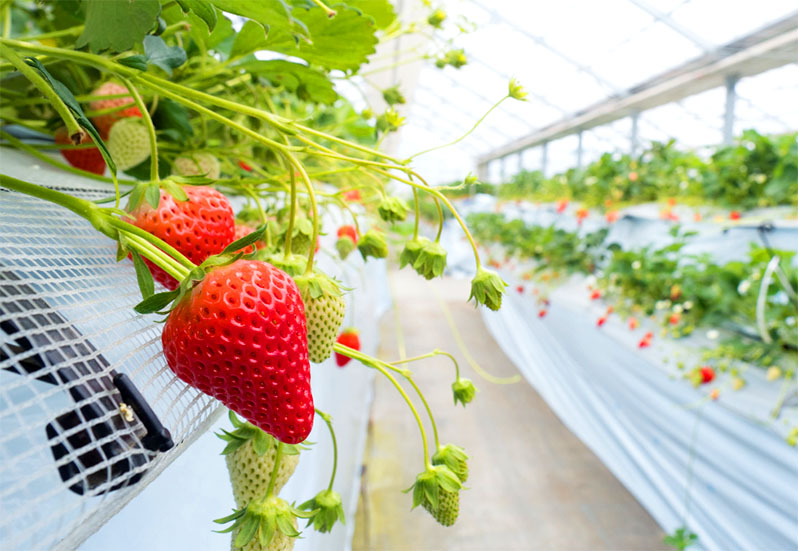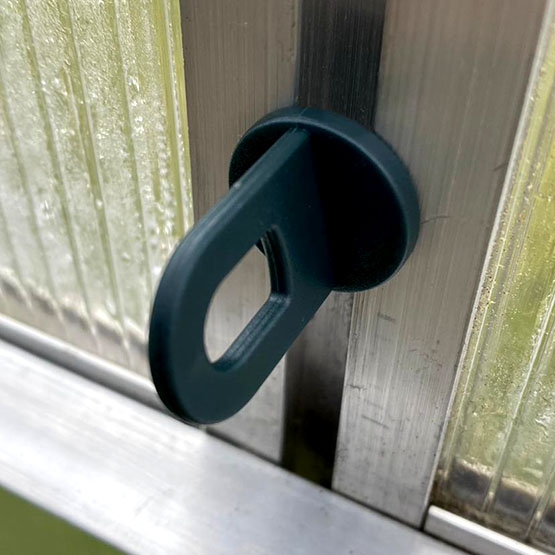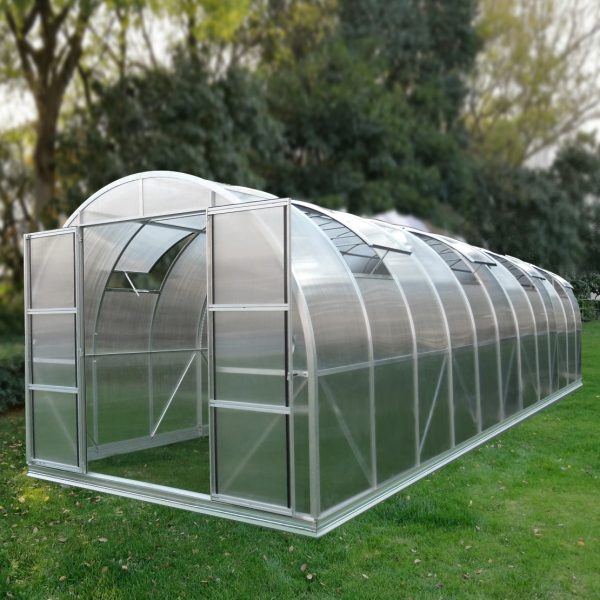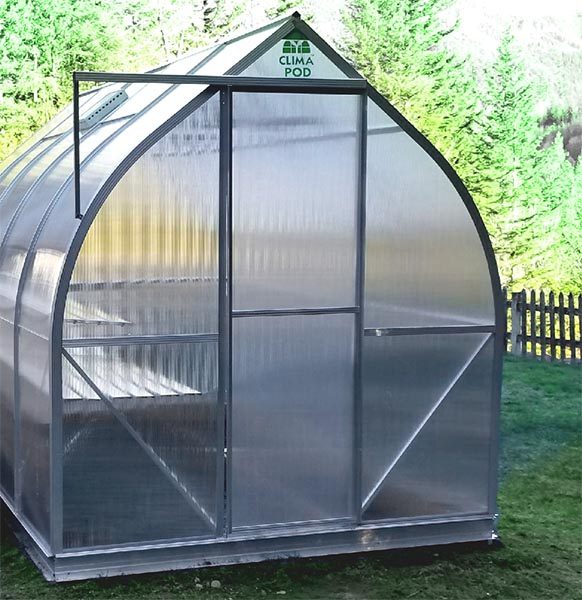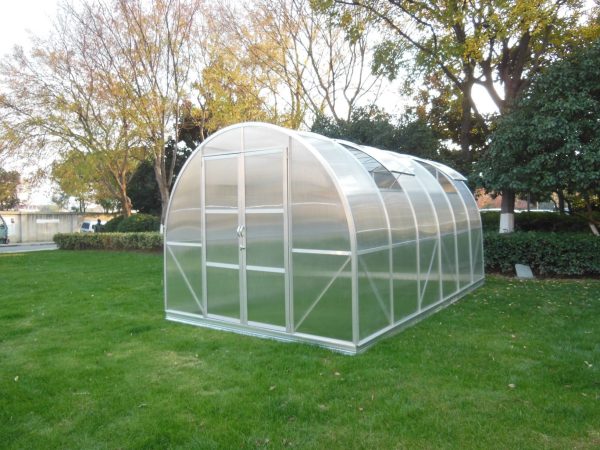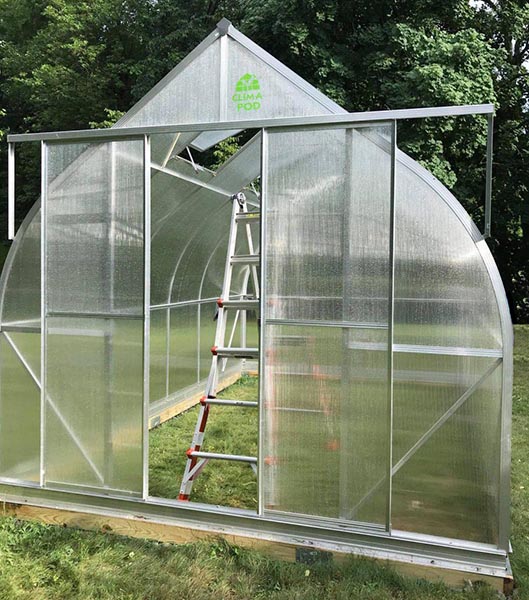The cost of equipment and materials, the complexity and frequency of care, and the amount of the harvest depend on the method of greenhouse strawberry cultivation.
Loved by many strawberries or strawberry can be grown even in the winter in greenhouses. Modern varieties and cultivation technologies allow to do this to any gardener. The year-round cultivation of strawberries, of course, will require labor, knowledge and financial investments from you, but it will give you the opportunity to have tasty and healthy berries on the table, regardless of the season and weather conditions.
Growing strawberries in the greenhouse will save space on the site with a compact placement of bushes, as well as save a large percentage of the crop. To get a high yield of strawberries it needs the right care.
Strawberry, though not particularly capricious plant, but still requiring proper care. This crop can be grown in almost any greenhouse type, but the most suitable are glass or polycarbonate greenhouses on a wooden or metal frame. You should create necessary conditions in greenhouse – to maintain the air temperature from + 10 ° С to + 25 ° С (at different periods of crop growth, different temperatures are needed) and air humidity in the range of 70-80%.
A rich and high-quality crop of berries when grown in a greenhouse will give strawberry sorts having the following characteristics:
- Self-fertility (ability to tie fruit without the participation of insects). After all, it is practically impossible to place a beehive in a winter greenhouse, and it is irrational to pollinate thousands of inflorescences on your own.
- Varieties of neutral days, which bear fruit continuously, tying fruit buds every 5-6 weeks.
- High-yielding sorts with maturation, transportable and leveled berries.
Remontant strawberry sorts perform well when grown in greenhouse conditions.
Experienced gardeners by perennial tests revealed several strawberry sorts, showing high yields when grown in covered ground:
- Crown,
- Queen Elizabeth,
- Elsanta,
- Sonata,
- Honey,
- San Andreas,
- Albion,
- Gigantella,
- Florina,
- Brighton,
- Octava
WAYS OF CULTIVATION STRAWBERRY IN THE GREENHOUSE
Soil for growing strawberries in the greenhouse
The first thing you should pay attention to before planting seedlings – the composition of the soil. You should prepare the soil in advance. You can achieve good results only in fertile soil.
The soil, not less than a month before the seedlings, is fertilized with humus or compost to saturate with the necessary microelements. Also you should carry in the peat, that will improve the air-and moisture-permeable qualities of the soil and optimize the level of acidity. If the soil is too acidic, it is necessary to add lime – 50 kg per one hundredth hectare.
Carry in superphosphate (30 g / 1 square meter) and potassium chloride (15 g / 1 square meter) into the pre-moistened soil immediately before planting.
Growing strawberries in a greenhouse in the classic way
Habitual for the gardener, and the easiest way to grow strawberries in the greenhouse in the ground on the usual or high ridges. Of course, this method limits the useful area of the greenhouse to one level of planting, but it allows you to spend a minimum of time on care.
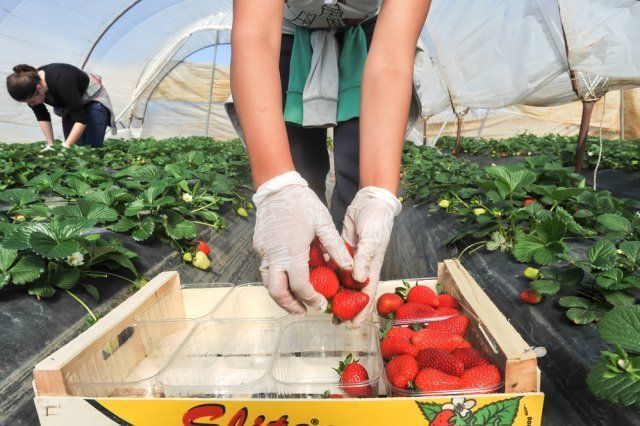
Landing is a two-line method or in a checkerboard pattern. The distance between the rows should be 30-40 cm, between bushes – 25-30 cm, between strips – 80-100 cm. If you bought seedlings in pots, then you should transplant them. Transfer the plants to 10 cm deep holes without breaking up the soil clod around the roots.
The point of growth of bushes should remain above the ground. Water the plants after planting and mulch with sawdust, straw or cover with spunbond to protect the plants from pests, the soil from drying out, and save yourself from weeds. Watering, in the first month after planting, carried out daily. Then – as the soil dries.
It is also necessary to ensure optimal conditions throughout the period of growth and fruiting of plants. At the initial stage of strawberry growth (in the first week after transplanting) it is necessary to maintain a temperature of + 10°C in the greenhouse. Further, the indicator is gradually raised to + 20°C. During the flowering period, the optimum temperature is from +20 to + 24°C.
An important microclimate parameter is humidity. It must be maintained within 80%, but during the flowering period it is necessary to lower by 5-10%. When the fruits begin to form, you will need another decrease in humidity by 5-10%.
Throughout the growth, flowering and fruiting of plants it is necessary to provide high-quality ventilation of the greenhouse.
Every 14-15 days, starting from the day of planting of the seedlings, fertilizers are applied – superphosphate and potassium salt.
The quality of lighting is extremely important for strawberries. This plant is warm and light-loving. If the daylight hours will last at least 16 hours, the berries will be formed as early as 35 days after transplanting. If the period of full coverage does not exceed 8 hours, the waiting period for the harvest will be longer (up to 1.5 months). We recommend to equip the artificial lighting of the greenhouse in insufficient sunlight.
Growing strawberries in polyethylene packages in a horizontal way
Practical Dutch technology allows to squeeze the maximum yield even from a small greenhouse. Strawberry bushes are planted in bags with nutritious soil and replaced after each fruiting by this technology.
Dutch technology of growing strawberries provides a significant increase in yield, but it is quite difficult to implement it. You need racks and installation of a complex branched drip irrigation system for planting.
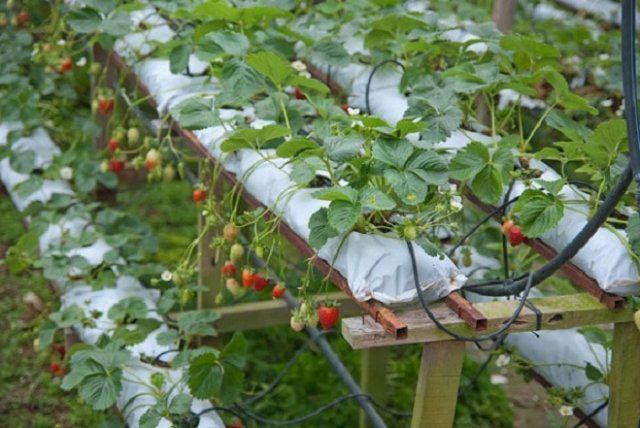
The essence of the technology is that the substrate is filled up in large dense plastic bags (preferably white), which are stacked on racks or suspended on fasteners. Desired bag sizes are 16×210 cm. Instead of plastic bags, you can use polypropylene bags.
At the bottom of the bags lay expanded clay as a drain, and then fill them with a substrate of peat and perlite in equal proportions (a mixture of turf soil, river sand, sawdust and humus will also do). Then along the package make incisions of 8 cm at a distance of 25-30 cm from each other. They put the bushes seedlings.
For the cultivation of strawberries using this technology will require the drip irrigation. To each package down 3 tube dropper. One tube is immersed on the lower layer of the substrate, the second – on the middle, the third – on the top. Water consumption – 0.5 l/day for 1 package.
Caring for strawberries planted with this technology is identical to caring for planted ones in the classic way.
Growing strawberries in plastic bags in a vertical way
This method of growing strawberries in a greenhouse is similar to the previous one in many ways. The same requirements apply to the substrate, to planting bags and even to the care of plants. But the technology of vertical cultivation has its advantages and features. By the way, now special bags for the vertical cultivation of strawberries have appeared on the market (in the photo below).
Firstly, drip irrigation is not required. Secondly, this method of planting culture allows the most efficient use of the internal space of the greenhouse.
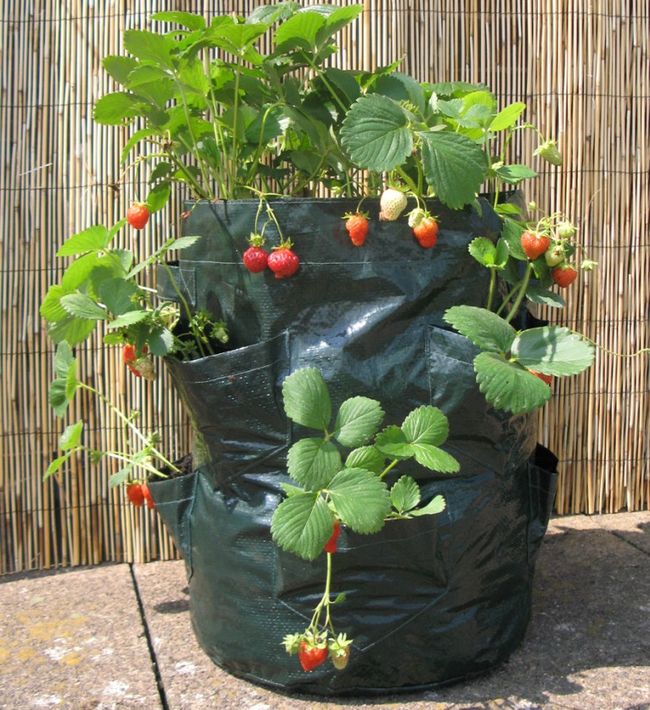
At the bottom of the bags lay expanded clay as a drain, and then fill them with a substrate of peat and perlite in equal proportions (a mixture of turf soil, river sand, sawdust and humus will also do). Make cuts on both sides of the bag. It is permissible to have both staggered and even rows, 8 cm at a distance of 25-30 cm from each other. In the slot placed seedlings bushes. The bags are hung, for example, to the upper beams of the greenhouse. It is important to keep the distance between the suspended tanks – it should be at least 40 cm. Optimally – 60 cm.
Growing strawberries in pots
This method will suit even very small greenhouses. It involves planting strawberry seedlings in separate pots. You can simply hang them in a greenhouse or set them on racks in several stages.

For planting strawberries in pots, it is necessary to prepare the substrate from 2 parts of peat, one part of perlite and 2 parts of sawdust.
Pots should be 18–20 cm in diameter, made of plastic or ceramic, but not metal.
Planted strawberry bushes like for ordinary houseplants: put a layer of drainage on the bottom, fill the pot with a moistened substrate, carefully place the root system in the hole and sprinkle it with the substrate, lightly tamping it. At the end of planting the plants need to be watered. It is important not to forget about the presence of a drain hole in the pot to remove excess moisture.
Carry out roles, illumination and top dressing in the same way as in previous cases. But you need to minimize plant care.
Important! This method of cultivation is not suitable for sort that form a very powerful root system and tall stems.
Growing strawberries vertically in PVC pipes
Strawberries grown in pipes have a number of advantages over their counterparts growing in uncovered ground. The weeds do not drown the strawberries, it does not have to loosen, and it reliably “insured” from all pests crawling on the ground. In addition, pipes are more durable than plastic bags and do not require frequent replacement.
However, diseases attack it even more, moreover, the soil in the pipes quickly dries out and depletes. Therefore, the care of the gardener does not disappear, but only shifted to another area. By the way, you may grow strawberries in tubes horizontally.
The main time in the process of planting strawberries takes away the assembling and preparation of the pipes structures. In order to make it, you will need not only the pipes themselves, but also certain tools:
- PVC pipes with a diameter of 20 cm (sewer)
- End caps with a diameter of 20 cm (1 piece for each tube)
- PVC pipes with a diameter of 10 cm
- End caps with a diameter of 10 cm (1 piece for each pipe)
- A piece of water hose
- Drill with crowns with a diameter of 6 and 8 cm
- Construction dryer
- Hacksaw
In the pipe section of 100 mm with a screwdriver and a crown cut holes so that they are located on the same line and are at a distance of 20-25 cm from each other.

Cut out 8-crown holes in a pipe with a diameter of 200 mm, so that only the upper part of the circle is cut. To do this, while cutting hold the crown at an angle to the pipe. You need to get a cut in the form of a half circle. You will be able to do this by controlling the force on the tool. Bend the cut parts of the circles in a large pipe, heating them with a building dryer.
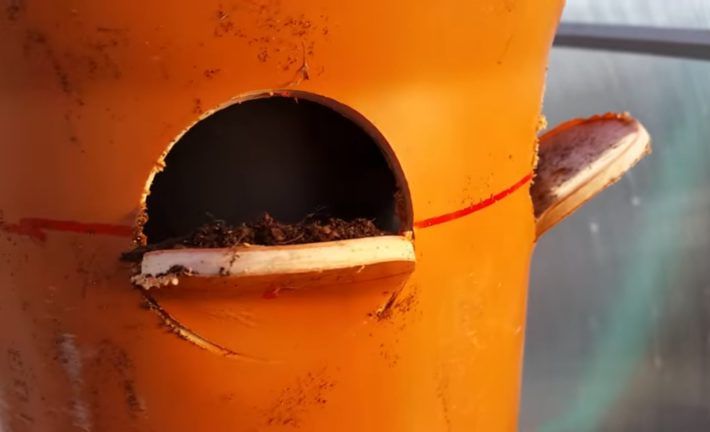
Close the lower end of the narrow tube with a cap of the appropriate size. Inserted a pipe with a section of 100 mm into a pipe with a section of 200 mm. Fix the narrower tube with wire and wooden sticks so that it is located exactly in the center. Fill the free space between the pipes with soil (composition of the extract: peat and perlite in equal proportions (a mixture of turf soil, river sand, sawdust and humus will also be suitable in a ratio of 2: 1: 1: 1)
Close the lower end of the wide one with a lid of a suitable size. Before that, you should drill a few holes in the lid to let excess water out.
Fill the inner space of a narrow pipe with organic material mixed with sawdust.
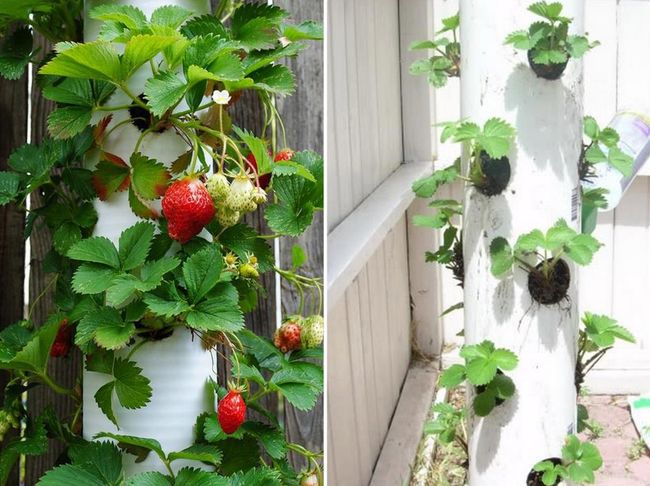
Planted in the holes of a large pipe strawberry seedlings. Structures are suspended in the greenhouse. The optimal distance is 60 cm. Water the plants 1-2 times a week by pouring water into a narrow pipe. The rest of the care is identical to the previous methods of planting strawberries in the greenhouse.

